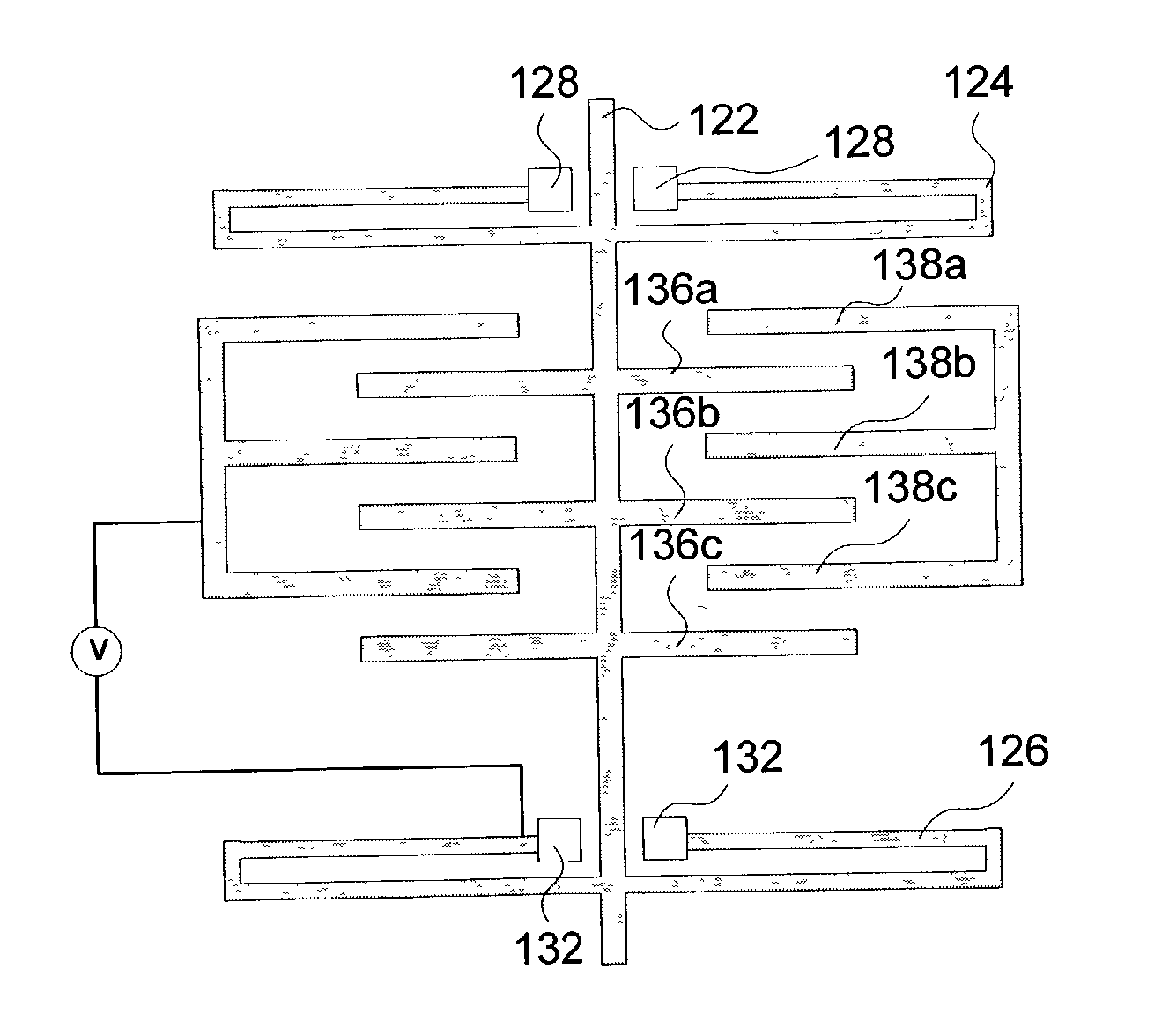Complex microdevices and apparatus and methods for fabricating such devices
a micro-device and complex technology, applied in the direction of acceleration measurement using interia forces, instruments, coatings, etc., can solve the problems of electrostatic devices proposed or developed, monolithic formation, and destructive separation of masking material from the substra
- Summary
- Abstract
- Description
- Claims
- Application Information
AI Technical Summary
Benefits of technology
Problems solved by technology
Method used
Image
Examples
first embodiment
[0111] FIG. 4 illustrates a pressure sensor according to a This pressure sensor includes a plurality of stacked capacitor plates that may by used to enhance the sensitivity of any displacement caused by a pressure differential. The pressure sensor of the present embodiment includes a base plate 102 through which conductive leads 104 and 106 extend. Conductive lead 106 connects to walls 108 and flexible lid member 112 when a pressure P is exerted on the outside lid member 112 which exceeds a pressure P inside a chamber 114 formed by base 102 walls 108 and lid 112, a downward deflection of lid 112 occurs which causes a deflection of capacitive plates 116(a), 116(b) and 116(c) relative to capacitive plates 118(a), 118(b), and 118(c). This deflection causes a change in the capacitance of the capacitor that is formed by set of plates 116(a)-116(c) and 118(a)-118(c). This change in capacitance can be detected and correlated to a pressure differential. Due to the existence of multiple cap...
third embodiment
[0116] the invention is depicted in FIGS. 6(a)-6(c). FIG. 6(a) depicts a perspective view of the moving portion of an actuator while FIG. 6(b) depicts an expanded view of a portion of the structure of FIG. 6(a) such that individual capacitor plates can be seen in several of the stacks. FIG. 6(c) depicts a top view of both the moving elements and the fixed elements of the actuator of FIGS. 6(a) and 6(b). The moving elements of actuator 6(a) include a plurality of stacks 142a-142r of capacitor plates where each stack itself includes a plurality of capacitor plates as illustrated in FIG. 6(b) as 142a(1), 142a(2), 142a(3), etc. The moving elements also include a shaft 144 and columns 146 that connect all of the capacitor plates into a single structure. Shaft 144 is supported by spring-like elements 148 and 150 which in turn have one end 152 and 154 connected to columns 156 and 158 that extend to a frame (not shown). For clarity of presentation FIGS. 6(a) and 6(b) do not depict the plura...
fourth embodiment
[0117] the present invention provides a linear variable differential transformer or LVDT which may be monolithically produced by electrochemical fabrication. As indicated in FIG. 7, the LVDT may consist of a primary transformer coil 180 and two secondary transformer coils 182a and 182b. Additionally, an armature of magnetically permeable material is included that may move back and forth such that different amounts of the armature may be located in secondary coils 182a or 182b. Armature 184 may have a non-magnetically permeable extension extending out of one or both ends of the secondary coils as indicated by reference numbers 186a and 186b. In use, the LVDT may be supplied with a voltage V1 on primary coils 180 and a voltage difference V2 between the two secondary coils may be detected, to yield a value which can be related to the position of armature 184. Armature 184 is connected via elements 186a or 186b to a structure whose position is to be measured. The detected voltage V2 may...
PUM
| Property | Measurement | Unit |
|---|---|---|
| Aspect Ratio | aaaaa | aaaaa |
| actuation voltages | aaaaa | aaaaa |
| thickness | aaaaa | aaaaa |
Abstract
Description
Claims
Application Information
 Login to View More
Login to View More - R&D
- Intellectual Property
- Life Sciences
- Materials
- Tech Scout
- Unparalleled Data Quality
- Higher Quality Content
- 60% Fewer Hallucinations
Browse by: Latest US Patents, China's latest patents, Technical Efficacy Thesaurus, Application Domain, Technology Topic, Popular Technical Reports.
© 2025 PatSnap. All rights reserved.Legal|Privacy policy|Modern Slavery Act Transparency Statement|Sitemap|About US| Contact US: help@patsnap.com



